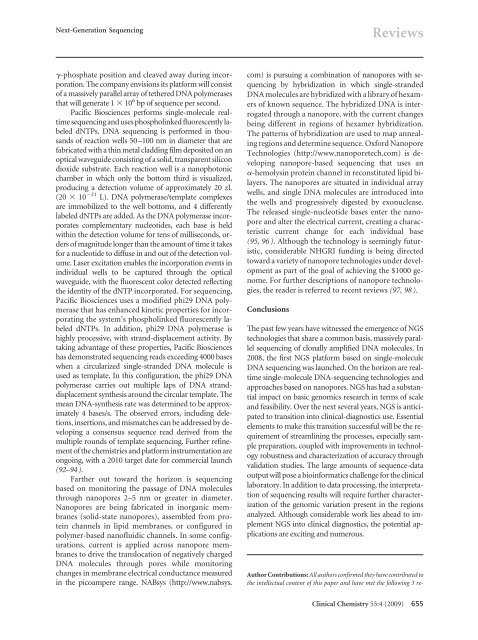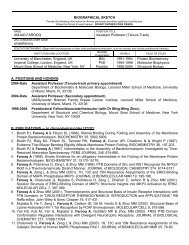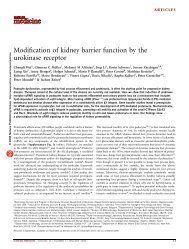Next-Generation Sequencing: From Basic Research to Diagnostics ...
Next-Generation Sequencing: From Basic Research to Diagnostics ...
Next-Generation Sequencing: From Basic Research to Diagnostics ...
Create successful ePaper yourself
Turn your PDF publications into a flip-book with our unique Google optimized e-Paper software.
<strong>Next</strong>-<strong>Generation</strong> <strong>Sequencing</strong>Reviews-phosphate position and cleaved away during incorporation.The company envisions its platform will consis<strong>to</strong>f a massively parallel array of tethered DNA polymerasesthat will generate 1 10 6 bp of sequence per second.Pacific Biosciences performs single-molecule realtimesequencing and uses phospholinked fluorescently labeleddNTPs. DNA sequencing is performed in thousandsof reaction wells 50–100 nm in diameter that arefabricated with a thin metal cladding film deposited on anoptical waveguide consisting of a solid, transparent silicondioxide substrate. Each reaction well is a nanopho<strong>to</strong>nicchamber in which only the bot<strong>to</strong>m third is visualized,producing a detection volume of approximately 20 zL(20 10 21 L). DNA polymerase/template complexesare immobilized <strong>to</strong> the well bot<strong>to</strong>ms, and 4 differentlylabeled dNTPs are added. As the DNA polymerase incorporatescomplementary nucleotides, each base is heldwithin the detection volume for tens of milliseconds, ordersof magnitude longer than the amount of time it takesfor a nucleotide <strong>to</strong> diffuse in and out of the detection volume.Laser excitation enables the incorporation events inindividual wells <strong>to</strong> be captured through the opticalwaveguide, with the fluorescent color detected reflectingthe identity of the dNTP incorporated. For sequencing,Pacific Biosciences uses a modified phi29 DNA polymerasethat has enhanced kinetic properties for incorporatingthe system’s phospholinked fluorescently labeleddNTPs. In addition, phi29 DNA polymerase ishighly processive, with strand-displacement activity. Bytaking advantage of these properties, Pacific Bioscienceshas demonstrated sequencing reads exceeding 4000 baseswhen a circularized single-stranded DNA molecule isused as template. In this configuration, the phi29 DNApolymerase carries out multiple laps of DNA stranddisplacementsynthesis around the circular template. Themean DNA-synthesis rate was determined <strong>to</strong> be approximately4 bases/s. The observed errors, including deletions,insertions, and mismatches can be addressed by developinga consensus sequence read derived from themultiple rounds of template sequencing. Further refinemen<strong>to</strong>f the chemistries and platform instrumentation areongoing, with a 2010 target date for commercial launch(92–94).Farther out <strong>to</strong>ward the horizon is sequencingbased on moni<strong>to</strong>ring the passage of DNA moleculesthrough nanopores 2–5 nm or greater in diameter.Nanopores are being fabricated in inorganic membranes(solid-state nanopores), assembled from proteinchannels in lipid membranes, or configured inpolymer-based nanofluidic channels. In some configurations,current is applied across nanopore membranes<strong>to</strong> drive the translocation of negatively chargedDNA molecules through pores while moni<strong>to</strong>ringchanges in membrane electrical conductance measuredin the picoampere range. NABsys (http://www.nabsys.com) is pursuing a combination of nanopores with sequencingby hybridization in which single-strandedDNA molecules are hybridized with a library of hexamersof known sequence. The hybridized DNA is interrogatedthrough a nanopore, with the current changesbeing different in regions of hexamer hybridization.The patterns of hybridization are used <strong>to</strong> map annealingregions and determine sequence. Oxford NanoporeTechnologies (http://www.nanoporetech.com) is developingnanopore-based sequencing that uses an-hemolysin protein channel in reconstituted lipid bilayers.The nanopores are situated in individual arraywells, and single DNA molecules are introduced in<strong>to</strong>the wells and progressively digested by exonuclease.The released single-nucleotide bases enter the nanoporeand alter the electrical current, creating a characteristiccurrent change for each individual base(95, 96). Although the technology is seemingly futuristic,considerable NHGRI funding is being directed<strong>to</strong>ward a variety of nanopore technologies under developmentas part of the goal of achieving the $1000 genome.For further descriptions of nanopore technologies,the reader is referred <strong>to</strong> recent reviews (97, 98).ConclusionsThe past few years have witnessed the emergence of NGStechnologies that share a common basis, massively parallelsequencing of clonally amplified DNA molecules. In2008, the first NGS platform based on single-moleculeDNA sequencing was launched. On the horizon are realtimesingle-molecule DNA-sequencing technologies andapproaches based on nanopores. NGS has had a substantialimpact on basic genomics research in terms of scaleand feasibility. Over the next several years, NGS is anticipated<strong>to</strong> transition in<strong>to</strong> clinical-diagnostics use. Essentialelements <strong>to</strong> make this transition successful will be the requiremen<strong>to</strong>f streamlining the processes, especially samplepreparation, coupled with improvements in technologyrobustness and characterization of accuracy throughvalidation studies. The large amounts of sequence-dataoutput will pose a bioinformatics challenge for the clinicallabora<strong>to</strong>ry. In addition <strong>to</strong> data processing, the interpretationof sequencing results will require further characterizationof the genomic variation present in the regionsanalyzed. Although considerable work lies ahead <strong>to</strong> implementNGS in<strong>to</strong> clinical diagnostics, the potential applicationsare exciting and numerous.Author Contributions: All authors confirmed they have contributed <strong>to</strong>the intellectual content of this paper and have met the following 3 re-Clinical Chemistry 55:4 (2009) 655




